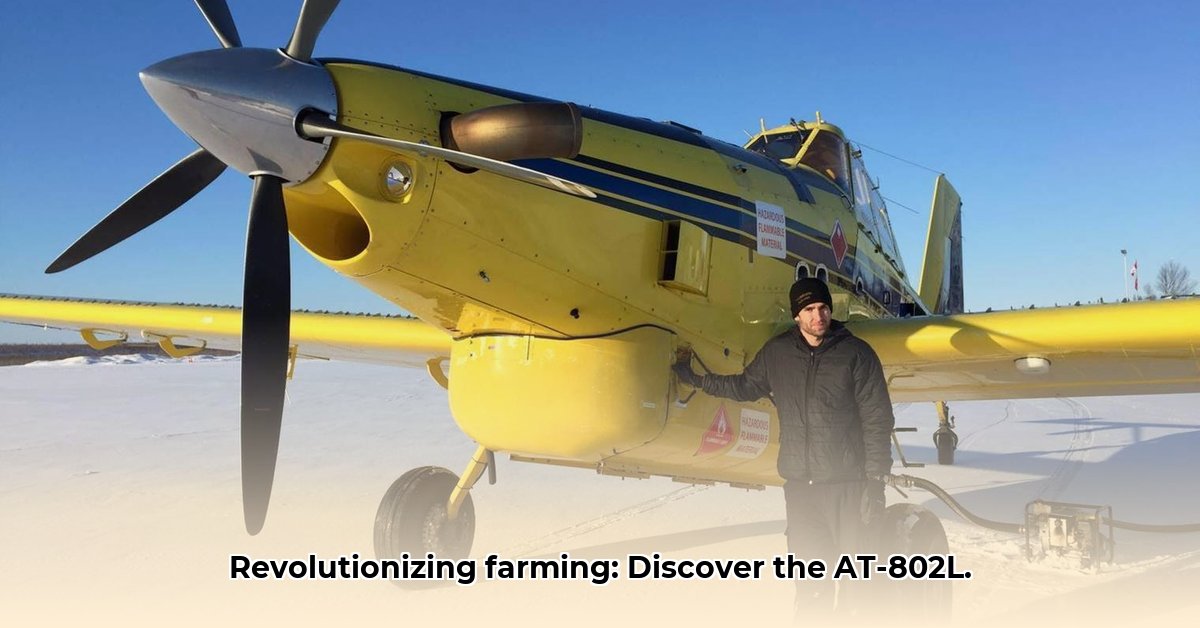
The Air Tractor AT-802L isn't your grandfather's crop duster. This powerful aircraft is revolutionizing sustainable agriculture, offering a blend of efficiency and environmental consciousness that's reshaping farming practices worldwide. But how does it work, and what are the implications for a future of sustainable food production? Let's delve into the details. For more on aviation history, check out this site on vintage tractors.
The AT-802L: Precision and Power in the Skies
Imagine a plane capable of covering vast fields with pinpoint accuracy, applying crucial resources only where needed. That's the essence of the AT-802L. Its massive 820-gallon tank allows for rapid coverage, translating to significant time and cost savings for farmers. But the real impact lies in its contribution to precision agriculture. This isn't simply about speed; it's about minimizing waste and maximizing environmental stewardship. The advanced navigation systems, such as the Garmin G600 suite, enable targeted application of fertilizers and pesticides, drastically reducing chemical runoff and protecting beneficial insects. Isn't it remarkable how technology can enhance sustainability?
A Case Study: Targeted Fertilizer Application
Consider a farmer utilizing the AT-802L to address nitrogen deficiency in a corn field. Through soil sampling or drone imagery, areas needing supplemental nitrogen are identified. The AT-802L then applies fertilizer precisely to these areas, avoiding unnecessary application elsewhere. This approach saves money, minimizes environmental impact from excess fertilizer use, and optimizes crop yields. This isn't just theoretical; numerous farms are already seeing these benefits.
Beyond the Fields: Versatility and Adaptability
The AT-802L’s capabilities extend beyond crop dusting. Its use as a firefighting aircraft (the Fire Boss) demonstrates its robust design and adaptability, highlighting the versatility of its engineering. This adaptability showcases a crucial aspect of sustainable practices: maximizing resource utilization. The potential cross-sector applications offer exciting opportunities for future innovation. What other ingenious uses might we discover for this adaptable machine?
Environmental Considerations: A Balanced Perspective
While the AT-802L offers immense potential for sustainable agriculture, acknowledging potential drawbacks is crucial. Even with precise application, the use of any chemical inputs necessitates careful consideration of environmental impact. Minimizing chemical reliance through exploration of bio-based alternatives remains a critical area for future development. Responsible use and continuous innovation are paramount to mitigate any potential downsides. Research into environmentally friendly crop treatments applicable via the AT-802L is ongoing and promising.
Accessibility and Equitable Sustainability
The significant investment required for an AT-802L presents a challenge. Its high cost limits accessibility for many smaller farms and farmers, particularly in developing countries. However, initiatives are underway to address this inequity. Government subsidies, cooperative ownership models, and leasing programs are emerging to increase accessibility, ensuring that the benefits of this technology are shared broadly. How can we further expand access to this vital tool for sustainable farming, ensuring equitable distribution of its benefits?
Future Synergies: Drones and the AT-802L
The future of agriculture will likely involve powerful partnerships. Imagine the AT-802L working in synergy with drones. Drones could provide real-time data on crop health, guiding the plane for even more precise treatment. This integration would accelerate precision agriculture, further optimizing resource use and minimizing environmental impact. This dynamic approach ensures efficient and adaptive farming practices.
Navigating the Path Ahead: A Collaborative Approach
The AT-802L represents a significant step toward sustainable agriculture, but continuous improvement remains vital. Ongoing research into more precise application methods, reducing chemical dependency, and expanding accessibility are crucial for maximizing its impact. This isn't just about efficiency; it's about building a more sustainable food system for both present and future generations.
Key Takeaways:
- Enhanced Efficiency: The AT-802L offers substantial improvements in speed and coverage, reducing labor costs and operational time.
- Precision Application: Targeted application minimizes chemical use and protects natural resources.
- Versatility: Its capabilities extend beyond agriculture, showcasing adaptable design principles.
Next Steps:
- Invest in R&D: Further research into advanced application technologies and bio-based alternatives is essential.
- Policy Support: Government programs can provide crucial support for farmers adopting this technology.
- Technological Integration: Exploring seamless drone integration and user-friendly data analysis tools.
- Education and Training: Comprehensive training programs are vital for responsible and effective use of the AT-802L.
The Air Tractor AT-802L is more than just an aircraft; it signifies a commitment to innovative and sustainable agricultural practices. Its continued development and responsible implementation are essential for building a future where food security and environmental sustainability coexist.